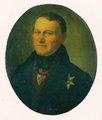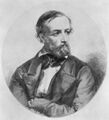Template:Selected anniversaries/July 27: Difference between revisions
No edit summary |
No edit summary |
||
| (35 intermediate revisions by the same user not shown) | |||
| Line 1: | Line 1: | ||
<gallery> | <gallery> | ||
||1733 | ||1733: Jeremiah Dixon born ... surveyor and astronomer. No pics online. | ||
|| | File:Erik Laxmann.png|link=Erik Laxmann (nonfiction)|1737: Natural scientist, explorer, and clergyman [[Erik Laxmann (nonfiction)|Erik Laxmann]] born. Laxmann will contribute to the taxonomy of Siberian fauna, and attempt to establish relations between Imperial Russia and Tokugawa Japan. | ||
||1775 | ||1759: Pierre Louis Maupertuis dies ... mathematician and philosopher. | ||
||1775: Founding of the U.S. Army Medical Department: The Second Continental Congress passes legislation establishing "an hospital for an army consisting of 20,000 men." | |||
||1777: Heinrich Wilhelm Brandes born ... physicist, meteorologist, and astronomer. | |||
File:George Biddell Airy 1891.jpg|link=George Biddell Airy (nonfiction)|1801: Mathematician and astronomer [[George Biddell Airy (nonfiction)|George Biddell Airy]] born. His achievements will include work on planetary orbits, measuring the mean density of the Earth, and, in his role as Astronomer Royal, establishing Greenwich as the location of the prime meridian. | File:George Biddell Airy 1891.jpg|link=George Biddell Airy (nonfiction)|1801: Mathematician and astronomer [[George Biddell Airy (nonfiction)|George Biddell Airy]] born. His achievements will include work on planetary orbits, measuring the mean density of the Earth, and, in his role as Astronomer Royal, establishing Greenwich as the location of the prime meridian. | ||
|| | File:Peter Gustav Lejeune Dirichlet.jpg|link=Peter Gustav Lejeune Dirichlet (nonfiction)|1837: [[Peter Gustav Lejeune Dirichlet (nonfiction)|Peter Dirichlet]] presented his first analytic number theory paper at a meeting of the Berlin Academy of Sciences. He proved the fundamental theorem that bears his name: Every arithmetical sequence an + b, n = 0, 1, 2, ... of integers, where a and b are relatively prime, contains infinitely many primes. | ||
File:John Dalton by Charles Turner.jpg|link=John Dalton (nonfiction)|1844: Chemist, meteorologist, and physicist [[John Dalton (nonfiction)|John Dalton]] dies. He proposed the modern atomic theory, and did research in color blindness. | |||
||1848 | ||1848: Loránd Eötvös born ... physicist and politician, Minister of Education of Hungary. Pic. | ||
|| | ||1849: John Hopkinson born ... physicist and electrical engineer who worked on the application of electricity and magnetism in devices like the dynamo and electromagnets. Hopkinson's law (the magnetic equivalent of Ohm's law) bears his name. In 1882, he patented his invention of the three-wire system (three phase) for electricity generation and distribution. He presented the principle the synchronous motors (1883), and designed electric generators with better efficiency. He also studied condensers and the phenomena of residual load. In his earlier career, he became (1872) engineering manager of Chance Brothers and Co., a glass manufacturer in Birmingham, where he studied lighthouse illumination, improving efficiency with flashing groups of lights. Pic: https://es.wikipedia.org/wiki/John_Hopkinson | ||
|| | ||1866: The first permanent transatlantic telegraph cable is successfully completed, stretching from Valentia Island, Ireland, to Heart's Content, Newfoundland. | ||
|| | ||1867: Derrick Norman Lehmer born ... mathematician and number theorist. Pic. | ||
|| | File:Ernst Zermelo 1900s.jpg|link=Ernst Zermelo (nonfiction)|1871: Logician and mathematician [[Ernst Zermelo (nonfiction)|Ernst Friedrich Ferdinand Zermelo]] born. His work will have major implications for the foundations of mathematics; he will be known for his role in developing Zermelo–Fraenkel axiomatic set theory, and for his proof of the well-ordering theorem. | ||
||1881: Hans Fischer born ... chemist and academic, Nobel Prize laureate. Pic. | |||
|| | ||1882: Geoffrey de Havilland born ... pilot and engineer, founded the de Havilland Aircraft Company. | ||
|| | ||1890: Vincent van Gogh shoots himself and dies two days later. | ||
||1921 | ||1893: Allen Goodrich Shenstone born ... physicist. He earned bachelor's, master's, and Ph.D. degrees from Princeton University, as well as a Bachelor of Arts from the University of Cambridge. After a brief stint as a junior faculty member at the University of Toronto, he returned to Princeton, where he was a professor in the Department of Physics 1925–62. He chaired the department 1949–60. He worked primarily in the field of atomic spectroscopy. Pic search. | ||
||1904: Kenneth Tompkins Bainbridge born ... physicist at Harvard University who did work on cyclotron research. His precise measurements of mass differences between nuclear isotopes allowed him to confirm Albert Einstein's mass-energy equivalence concept. He was the Director of the Manhattan Project's Trinity nuclear test, which took place July 16, 1945. Bainbridge described the Trinity explosion as a "foul and awesome display". He remarked to J. Robert Oppenheimer immediately after the test, "Now we are all sons of bitches." Pic. | |||
||1907: Irene Fischer born ... geodesist and mathematician. Pic search. | |||
||1917: Emil Theodor Kocher dies ... physician and academic, Nobel Prize laureate. Pic. | |||
||1921: Jonas Kubilius born ... mathematician who worked in probability theory and number theory. Pic. | |||
||1921: Researchers at the University of Toronto, led by biochemist Frederick Banting, prove that the hormone insulin regulates blood sugar. | |||
||1927: Yuri Nikolaevich Denisyuk born ... physicist, one of the founders of optical holography. He is known for his great contribution to holography, in particular for the so-called "Denisyuk hologram". Pic. | |||
File:John Ambrose Fleming 1890.png|link=John Ambrose Fleming (nonfiction)|1928: Electrical engineer and physicist [[John Ambrose Fleming (nonfiction)|John Ambrose Fleming]] marries the popular young singer Olive May Franks of Bristol. | File:John Ambrose Fleming 1890.png|link=John Ambrose Fleming (nonfiction)|1928: Electrical engineer and physicist [[John Ambrose Fleming (nonfiction)|John Ambrose Fleming]] marries the popular young singer Olive May Franks of Bristol. | ||
|1931 | ||1931: Jacques Herbrand dies in a mountain-climbing accident ... mathematician and philosopher. He worked in mathematical logic and class field theory. He introduced recursive functions. Herbrand's theorem refers to either of two completely different theorems. One is a result from his doctoral thesis in proof theory, and the other one half of the Herbrand–Ribet theorem. Pic. | ||
||1931: Auguste Forel dies ... myrmecologist, neuroanatomist, psychiatrist and eugenicist, notable for his investigations into the structure of the human brain and that of ants. For example, he is considered a co-founder of the neuron theory. Forel is also known for his early contributions to sexology and psychology. Pic. | |||
File:Gary Gygax Gen Con 2007.jpg|link=Gary Gygax (nonfiction)|1938: Game designer [[Gary Gygax (nonfiction)|Gary Gygax]] born. | File:Gary Gygax Gen Con 2007.jpg|link=Gary Gygax (nonfiction)|1938: Game designer [[Gary Gygax (nonfiction)|Gary Gygax]] born. | ||
He will co-create the pioneering role-playing game [[Dungeons & Dragons (nonfiction)|Dungeons & Dragons]] (D&D) with Dave Arneson. | |||
||1949: Initial flight of the de Havilland Comet, the first jet-powered airliner. | |||
||1951: Paul Kogerman dies ... chemist and politician, founder of modern research in oil shale. Pic. | |||
||1960: Julie Vinter Hansen dies ... astronomer and academic. Pic. | |||
||1963: Garrett Morgan dies ... inventor. Pic. | |||
|| | File:Cantor Parabola.jpg|link=Cantor Parabola|1973: Math photographer [[Cantor Parabola]] takes advance photographs of the House of Representatives Judiciary Committee voting to recommend the first article of impeachment against President Nixon. | ||
|| | File:Nixon April-29-1974.jpg|link=Watergate scandal (nonfiction)|1974: [[Watergate scandal (nonfiction)]]: The House of Representatives Judiciary Committee votes 27 to 11 to recommend the first article of impeachment (for obstruction of justice) against President Richard Nixon. | ||
|| | ||1982: Joseph Oscar Irwin dies ... statistician who advanced the use of statistical methods in biological assay and other fields of laboratory medicine. Irwin’s grasp of modern mathematical statistics distinguished him not only from older medical statisticians like Major Greenwood but contemporaries like Austin Bradford Hill. Pic. | ||
||1987: Jan Mikusiński dies ... mathematician based at the University of Wrocław known for his pioneering work in mathematical analysis. Mikusiński developed an operational calculus – known as the Calculus of Mikusiński (MSC 44A40), which is relevant for solving differential equations. His operational calculus is based upon an algebra of the convolution of functions with respect to the Fourier transform. From the convolution product he goes on to define what in other contexts is called the field of fractions or a quotient field. These ordered pairs of functions Mikusiński calls operators – Mikusiński Operator. Pic: http://www.math.us.edu.pl/instytut/historia/mikusinski/mikusinski.html | |||
||1988: Frank Zamboni dies ... inventor and businessman, founded the Zamboni Company. | |||
||1999: Aleksandr Danilovich Aleksandrov dies ... mathematician, physicist, and mountaineer. Pic search. | |||
|| | ||2011: First Earth trojan asteroid discovered from WISE data ... Wide-field Infrared Survey Explorer (WISE) launched ... NASA infrared-wavelength astronomical space telescope launched in December 2009, and placed in hibernation in February 2011.It was re-activated in 2013. WISE discovered thousands of minor planets and numerous star clusters. Its observations also supported the discovery of the first Y Dwarf and Earth trojan asteroid. Pic. | ||
|| | ||2015: John William Scott "Ian" Cassels dies ... mathematician ... writing a series of papers connecting the Selmer group with Galois cohomology and laying some of the foundations of the modern theory of infinite descent[citation needed]. His best-known single result may be the proof that the Tate-Shafarevich group, if it is finite, must have order that is a square; the proof being by construction of an alternating form. Pic: http://www.learn-math.info/mathematicians/historyDetail.htm?id=Cassels&menuH=wiki | ||
</gallery> | </gallery> | ||
Latest revision as of 10:23, 7 February 2022
1737: Natural scientist, explorer, and clergyman Erik Laxmann born. Laxmann will contribute to the taxonomy of Siberian fauna, and attempt to establish relations between Imperial Russia and Tokugawa Japan.
1801: Mathematician and astronomer George Biddell Airy born. His achievements will include work on planetary orbits, measuring the mean density of the Earth, and, in his role as Astronomer Royal, establishing Greenwich as the location of the prime meridian.
1837: Peter Dirichlet presented his first analytic number theory paper at a meeting of the Berlin Academy of Sciences. He proved the fundamental theorem that bears his name: Every arithmetical sequence an + b, n = 0, 1, 2, ... of integers, where a and b are relatively prime, contains infinitely many primes.
1844: Chemist, meteorologist, and physicist John Dalton dies. He proposed the modern atomic theory, and did research in color blindness.
1871: Logician and mathematician Ernst Friedrich Ferdinand Zermelo born. His work will have major implications for the foundations of mathematics; he will be known for his role in developing Zermelo–Fraenkel axiomatic set theory, and for his proof of the well-ordering theorem.
1928: Electrical engineer and physicist John Ambrose Fleming marries the popular young singer Olive May Franks of Bristol.
1938: Game designer Gary Gygax born.
1973: Math photographer Cantor Parabola takes advance photographs of the House of Representatives Judiciary Committee voting to recommend the first article of impeachment against President Nixon.
1974: Watergate scandal (nonfiction): The House of Representatives Judiciary Committee votes 27 to 11 to recommend the first article of impeachment (for obstruction of justice) against President Richard Nixon.








